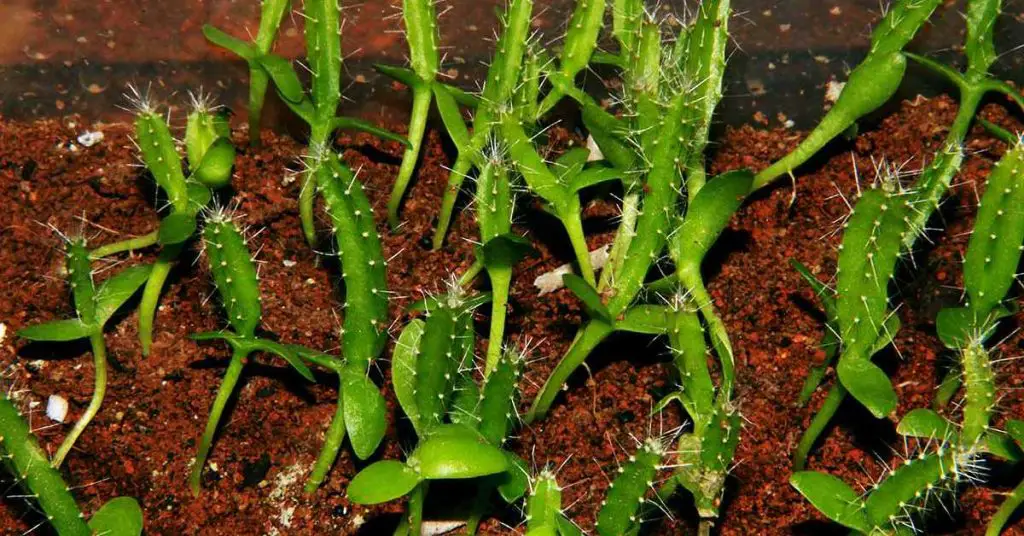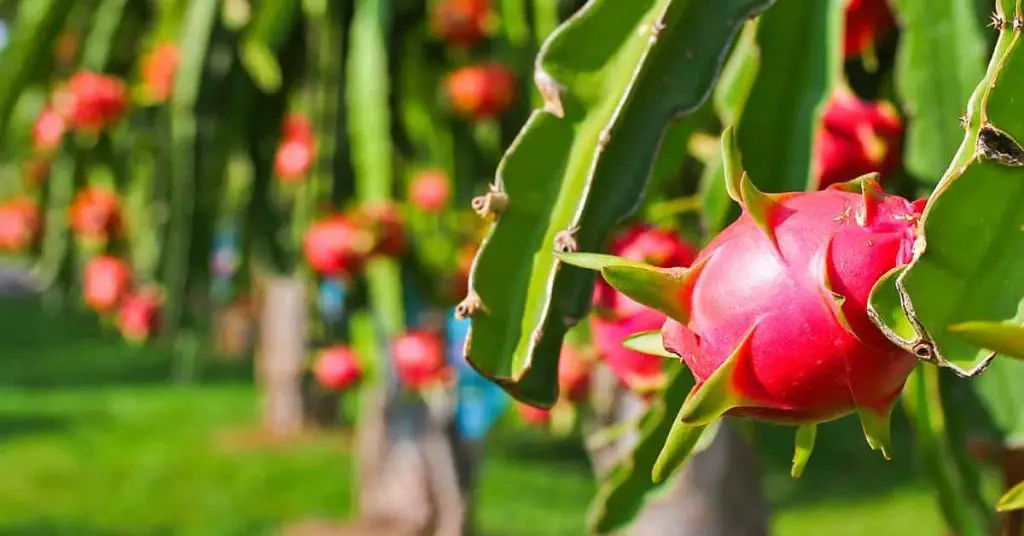If you’re interested in growing dragonfruit from seed, the process may seem challenging at first. However, with the right guidance and patience, you can discover the secrets to successfully nurturing these exotic plants.
From selecting the perfect seeds to creating an ideal environment for growth, each step plays an essential role in your dragonfruit’s journey from seed to fruit-bearing plant.
Ready to start on this rewarding horticultural adventure? Let’s begin by exploring the initial steps to set you on the path to dragonfruit cultivation success.

Key Takeaways
- Select fresh, plump seeds from healthy fruit for optimal germination.
- Plant seeds in well-draining soil mix at a shallow depth.
- Maintain consistent moisture and indirect light for germination.
- Transfer seedlings to larger pots as they grow.
- Use balanced fertilizer monthly to support growth.
Choosing the Right Dragonfruit Seeds
When selecting dragonfruit seeds for planting, make sure they’re fresh and sourced from healthy fruit to maximize germination success. Seed viability testing can help determine which seeds are most likely to sprout. Look for seeds that are plump, firm, and have a shiny appearance. Avoid seeds that are shriveled, discolored, or damaged as they may have lower germination rates.
To guarantee excellent germination success, consider soaking the seeds in water for 24 hours before planting. This can help soften the seed coat and promote quicker sprouting. Plant the seeds in a well-draining soil mix, keeping them moist but not waterlogged. Provide warmth and ample sunlight to encourage seedling growth.
Once the seedlings have emerged, it’s important to provide proper care. Ensure they receive sufficient water, sunlight, and nutrients. Protect them from pests and diseases by keeping the growing area clean and free from debris. With diligent seedling care, your dragonfruit plants will thrive and produce delicious fruits in the future.
Preparing the Planting Containers
To get the planting containers ready for your dragonfruit seeds, make sure they’re clean and have drainage holes at the bottom for proper water flow and aeration. For container selection, opt for pots that are at least 12 inches deep and wide to accommodate the growth of the dragonfruit plant. Plastic or terracotta containers work well, as long as they have those essential drainage holes.
When considering potting mix options, choose a well-draining soil mix suitable for cacti and succulents. A mix of cactus soil and perlite in a 2:1 ratio provides good drainage while retaining some moisture – important for the initial growth stages of your dragonfruit seeds. Avoid using regular garden soil, as it can become compacted and hinder seedling growth.
Prepare your containers by filling them with the chosen potting mix, leaving some space at the top for watering. Ensure the soil is lightly packed to provide stability for the seeds once planted. By selecting the right containers and potting mix, you’re setting the stage for successful dragonfruit seed germination.
Selecting the Ideal Growing Location
When selecting the perfect growing location for your dragonfruit plant, consider the sunlight requirements, soil conditions, and temperature considerations.
Guarantee your plant receives abundant sunlight, preferably 6-8 hours a day, in well-draining soil with a slightly acidic pH level.
Additionally, maintain a temperature range of 65-85°F (18-29°C) for best growth and fruit production.
This careful attention to these factors will help ensure the health and productivity of your dragonfruit plant.
Sunlight Requirements
For maximum growth of dragonfruit plants, make sure the selected growing location receives sufficient sunlight throughout the day. Dragonfruit plants thrive in full sun, requiring at least 6-8 hours of sunlight daily. Ideally, choose a spot in your garden or on your balcony that’s exposed to direct sunlight for the majority of the day. Sunlight is vital for the plant’s photosynthesis process, which is essential for its growth and fruit production.
When considering the sunlight requirements for your dragonfruit plants, take note of any potential obstructions that could shade the plant during the day. Structures like buildings or trees can cast shadows that may hinder the plant’s access to sunlight. Regularly monitor the selected location throughout the day to make sure that it meets the sunlight needs of the dragonfruit plant.
Providing adequate sunlight also helps in maintaining the plant’s temperature requirements and supports its growth patterns. Additionally, proper exposure to sunlight contributes to the overall health of the plant, reducing the need for extensive plant maintenance in the long run.

Soil Conditions
Selecting the ideal growing location for your dragonfruit plants depends on the soil conditions in the chosen spot. Dragonfruit plants thrive in well-draining soil with a pH balance between 6 and 7.5. Before planting, it’s crucial to test the soil to confirm it falls within this range. Adjustments can be made by adding materials such as peat moss to lower pH or agricultural lime to raise it.
In terms of nutrient requirements, dragonfruit plants benefit from a balanced fertilizer with a higher potassium content to promote flowering and fruiting. Organic matter like compost can also be added to the soil to enhance nutrient levels and soil structure.
When selecting a spot in your garden, choose an area that receives adequate sunlight and has good air circulation. Avoid waterlogged areas as excessive moisture can lead to root rot. By ensuring the soil conditions meet the pH balance and nutrient requirements of dragonfruit plants, you establish the foundation for healthy growth and bountiful harvests.
Temperature Considerations
To guarantee ideal growth for your dragonfruit plants, consider the temperature requirements when choosing the perfect spot for cultivation. Dragonfruit thrives in temperatures between 65°F to 80°F, with peak growth outcomes achieved around 70°F. Sudden temperature fluctuations can hinder plant development, so select a location with stable temperatures. Avoid areas prone to extreme heat or cold drafts, as these can stress the plants and impact their growth.
Humidity levels also play an important role in the successful cultivation of dragonfruit. Aim for a humidity range of 40% to 60% to create a favorable environment for your plants. High humidity can lead to issues like fungal diseases, while low humidity can cause dehydration in the plants. Monitoring and adjusting humidity levels accordingly will contribute to the overall health and productivity of your dragonfruit plants.
When selecting the ideal growing location, prioritize stable temperatures and appropriate humidity levels to ensure your dragonfruit plants flourish and produce bountiful harvests.
Sowing the Dragonfruit Seeds
When planting dragonfruit seeds, make sure you use a well-draining soil mix in a small pot or tray. Begin by filling the container with the soil mix, leaving about an inch from the top. Press the seeds gently into the soil, making sure they aren’t buried too deep. Cover them lightly with soil and mist the top with water to keep it moist. Place the pot or tray in a warm, sunny location, making certain it receives indirect light.
For successful seedling care and germination tips, maintain a consistent temperature around 70-90°F (21-32°C). It’s crucial to keep the soil consistently moist but not waterlogged. As the seeds germinate and seedlings grow, ensure they’re well-ventilated to prevent mold or disease. Once the seedlings have developed and are sturdy enough, around 4-6 inches tall, consider transplanting them carefully into individual pots to promote healthy root growth.
Following these seedling care and transplanting techniques will establish a strong foundation for your dragonfruit plants to thrive.
Providing Optimal Watering Conditions
To guarantee the healthy growth of your dragonfruit plants, it’s essential to pay attention to the watering frequency and maintain ideal soil moisture levels. By watering consistently but not excessively, you provide the necessary hydration without causing waterlogging, which can harm the plants.
Monitoring the moisture content in the soil is key to adjusting your watering schedule to meet the specific needs of your dragonfruit seedlings.
Watering Frequency
For best growth, make sure you water your dragonfruit plant consistently and evenly to maintain proper moisture levels in the soil. Establishing a watering schedule is vital for providing the necessary hydration needs for your dragonfruit plant, which in turn stimulates its growth. Water your plant regularly, typically every 7-10 days, especially during the growing season. However, adjust this frequency based on the specific requirements of your plant, considering factors like temperature and humidity levels.
Proper watering not only supports growth stimulation but also aids in root development. When watering your dragonfruit plant, make certain that the soil is moist but not waterlogged. Overwatering can lead to root rot, so it’s important to strike a balance. To check if your plant needs watering, insert your finger into the soil about an inch deep – if it feels dry, it’s time to water. Consistency in watering will help your dragonfruit plant thrive and produce healthy, delicious fruit.
Soil Moisture Levels
Maintain ideal soil moisture levels by guaranteeing consistent and even watering to promote healthy growth of your dragonfruit plant. Proper watering techniques are vital for seedling care and root development. Overwatering can lead to root rot, stunting growth, and even the death of your plant. Conversely, underwatering can stress the plant, inhibit root development, and hinder overall growth. To avoid these growth inhibitors, water your dragonfruit plant when the top inch of soil feels dry to the touch.
When watering, make sure that the water reaches the roots by watering the soil directly and avoiding wetting the plant’s stems and leaves excessively. Use a watering can or a gentle stream of water to provide even moisture distribution. Consider using a moisture meter to accurately gauge the soil’s moisture levels if you’re unsure. Remember, consistency is key – aim to water your dragonfruit plant regularly, but always adjust based on the plant’s specific needs. With proper watering care, your dragonfruit plant will thrive and reward you with vibrant growth and delicious fruits.
Ensuring Proper Drainage for Seedlings
Ensuring proper drainage for seedlings involves carefully selecting containers with adequate drainage holes and using well-draining soil to prevent waterlogging. Proper aeration is essential for the roots to thrive and grow healthily, while preventing root rot, a common issue in poorly drained soil.
Choose containers made of terracotta or plastic, ensuring they have drainage holes at the bottom to allow excess water to escape. Fill the containers with a well-draining cactus or succulent mix, or create your own by combining potting soil with perlite or coarse sand.
Before planting the dragonfruit seeds, water the soil lightly to moisten it without saturating it. Place the containers in an area with good air circulation to aid in drying out excess moisture. Remember to check the soil moisture regularly and adjust your watering schedule accordingly to maintain the right balance for your dragonfruit seedlings.
Creating a Warm and Humid Environment
To create a warm and humid environment for your dragonfruit seedlings, consider placing a humidity dome over the containers to retain moisture and warmth. Humidity management is essential during the germination phase. The dome helps in trapping moisture, creating a greenhouse effect that mimics the tropical climate where dragonfruit thrives. Make sure the dome has ventilation holes to prevent excessive humidity buildup, which can lead to fungal issues.
Temperature control is equally important. Dragonfruit seeds require consistent warmth to germinate successfully. Aim for a temperature range between 70-85°F (21-29°C) for best growth. To maintain warmth, consider using a heat mat underneath the containers. This helps in creating a stable and cozy environment for the seeds to sprout.
Regularly monitor the temperature and humidity levels within the dome to ensure they remain within the ideal range. Adjust ventilation or heating sources as needed to provide a comfortable setting for your dragonfruit seedlings. By carefully managing humidity and temperature, you’re setting the stage for healthy growth and development.
Monitoring Seed Germination Progress
Observe the dragonfruit seedlings daily to track their progress in germination. The key, ensure, for dragonfruit seeds can vary, but typically, you can expect to see sprouts emerging within 1 to 4 weeks after planting. During this period, make sure to keep the soil consistently moist but not waterlogged to support seedling growth.
To effectively monitor the seedling growth tracking, keep a journal or log where you record daily observations. Note any changes in the appearance of the seedlings, such as the emergence of cotyledons or the development of true leaves. This tracking will help you identify any issues early on and make adjustments if needed.
Pay close attention to the environmental conditions, such as temperature and light exposure, as these factors play a significant role in the germination process. By actively monitoring your dragonfruit seedlings, you can make sure they’ve the best chance of growing into healthy plants.
Transferring Seedlings to Larger Pots
When transferring your dragonfruit seedlings to larger pots, take into account the root development and size of the seedlings to make sure they’ve sufficient space for ongoing growth. The root system of the seedlings plays a vital role in their nutrient absorption and overall growth rate. Choosing the right pot size is essential to support healthy root development and allow the plant to thrive.
Before transferring the seedlings, select pots that are about 1-2 inches larger in diameter than their current pots. This extra space will encourage the roots to expand and prevent overcrowding. Make sure the new pots have drainage holes to prevent waterlogging, which can hinder root growth. Fill the bottom of the new pots with a layer of well-draining soil before carefully transferring the seedlings.
Gently loosen the soil around the seedlings to avoid damaging the roots. Place the seedlings in the center of the new pots and fill the remaining space with soil, pressing lightly to secure them. Water the seedlings gently after transplanting to help them settle into their new environment. This careful process will support healthy root development and promote optimal growth rates for your dragonfruit seedlings.
Introducing Fertilizer to Boost Growth
Consider integrating a balanced fertilizer into your dragonfruit care routine to enhance growth and support overall plant health. To achieve growth acceleration and maximize nutrient absorption, select a fertilizer with equal parts nitrogen, phosphorus, and potassium. Nitrogen promotes leafy growth, phosphorus supports root development, and potassium aids in overall plant health and fruit production.
When applying the fertilizer, follow the instructions on the packaging carefully to avoid over-fertilization, which can harm your dragonfruit plant. Typically, a monthly application during the growing season is sufficient. Remember to water your plant before and after fertilizing to help distribute the nutrients evenly in the soil and prevent root burn.
Observing your dragonfruit plant’s response to the fertilizer is important. Look for signs of healthy growth such as vibrant green leaves, sturdy stems, and an increase in the number of new shoots. Adjust the fertilizer application if you notice any negative effects like yellowing leaves or stunted growth. By providing the right nutrients in the form of a balanced fertilizer, you can effectively boost your dragonfruit’s growth and promote its overall well-being.
Protecting Seedlings From Pests and Diseases
To safeguard your dragonfruit seedlings, implement effective pest prevention methods, such as regular inspection for pests and applying natural repellents.
Combat diseases by practicing proper hygiene, using sanitized tools, and providing adequate air circulation.
Guarantee the overall health of your seedlings by maintaining ideal growing conditions, including proper watering and balanced nutrition.
Pest Prevention Methods
Implement these highly effective pest prevention methods to safeguard your dragonfruit seedlings from potential threats and diseases. Utilizing natural remedies can help protect your plants without harmful chemicals.
Neem oil, for example, is a natural insecticide that can deter pests like aphids and spider mites. Simply dilute it in water and spray it on your seedlings regularly.
Companion planting is another beneficial method to ward off pests. Consider planting marigolds near your dragonfruit seedlings, as they can repel nematodes and other harmful insects. Additionally, growing basil or mint nearby can deter pests like whiteflies.
Regularly inspect your seedlings for any signs of pest infestations or diseases. Early detection can prevent widespread damage. Remove any affected leaves or plants promptly to prevent the issue from spreading.
Disease Control Strategies
For effective disease control strategies to protect your dragonfruit seedlings from pests and diseases, thorough sanitation practices are essential. To prevent fungal infections and control pests, make sure that your planting area is free from debris and weeds that can harbor harmful organisms. Additionally, consider using natural solutions and organic remedies to keep your seedlings healthy.
When it comes to fungal infections prevention, one useful method is to avoid overwatering your seedlings. Fungi thrive in moist environments, so it’s important to maintain proper watering practices to prevent these issues. Additionally, promoting good air circulation around your plants can also help reduce the risk of fungal infections.
For effective pest control, inspect your seedlings regularly for any signs of pests such as mealybugs or spider mites. If you notice any pests, consider using natural pest control methods like neem oil or insecticidal soap to protect your dragonfruit seedlings without harming the environment. By implementing these organic remedies and practices, you can safeguard your seedlings and promote their healthy growth.
Healthy Seedling Practices
Maintain a vigilant approach by regularly inspecting your dragonfruit seedlings for pests and diseases, guaranteeing their protection and fostering healthy growth.
To safeguard your seedlings, provide them with proper nutrition to support robust growth. Guarantee they receive adequate water and sunlight, as well as a balanced fertilizer to promote strong development.
Additionally, consider pruning your seedlings to remove any damaged or diseased parts, encouraging new growth and preventing the spread of infections.
Support your seedlings by using stakes or trellises to help them grow upright and prevent them from bending or breaking under their weight as they mature.
By implementing these practices, you can protect your dragonfruit seedlings from pests and diseases, setting them on the path to thriving and producing bountiful fruit.
Stay attentive to their needs, and your dragonfruit seedlings will reward you with healthy growth and a flourishing garden.
Training Young Plants to Climb
To encourage young dragonfruit plants to climb, gently guide their growth along a sturdy trellis or support structure. Dragonfruit are natural climbers, and by training them early, you can make sure they grow in the desired direction. As the plant matures, it will send out aerial roots that help it grip onto the trellis or support structure.
These roots are essential for stability as the plant grows taller. When guiding the plant’s growth, be patient and avoid forcing it in a particular direction. Instead, gently coax the stems towards the trellis, allowing the plant to adapt naturally to the support.
Understanding the climbing techniques and growth patterns of dragonfruit is important for successful trellis training. Dragonfruit plants have a tendency to grow upwards, seeking sunlight and support for their weight. By providing the right support structures, such as a trellis, you can guide the plant’s growth effectively.
Secure the plant to the trellis loosely to prevent damage to the stems. With proper care and training, your young dragonfruit plant will soon thrive and climb with grace.

Harvesting Dragonfruit From Mature Plants
When harvesting dragonfruit from mature plants, make sure the fruit is ripe by checking for a bright color and slight softness to the touch. To harvest, grasp the fruit firmly and twist it off the stem. Avoid pulling as this can damage the plant. Once harvested, handle the fruit with care as it bruises easily.
For best taste, consume the fruit right away. If you need to store it, place the dragonfruit in a cool, dry place for up to 5 days. To extend its shelf life, refrigerate it for up to 2 weeks. When ready to eat, simply cut the fruit in half and scoop out the flesh with a spoon. Dragonfruit can also be added to smoothies, salads, or used as a colorful garnish for desserts.
Frequently Asked Questions
Can Dragonfruit Seeds Be Successfully Grown Indoors?
Yes, you can successfully grow dragonfruit seeds indoors. For indoor gardening, make sure seedlings receive ample sunlight. Container gardening is ideal for managing growth. By providing the right conditions, you can nurture dragonfruit seeds into healthy plants.
How Long Does It Take for Dragonfruit Seeds to Germinate?
To grow dragonfruit seeds, expect germination in 11-14 days. Provide warmth at 70-95°F, keep soil moist but not soggy. Guarantee proper seedling care with consistent watering and gradual exposure to sunlight. Your patience will be rewarded with healthy seedlings.
Are There Any Specific Pests That Target Dragonfruit Seedlings?
When caring for your dragonfruit seedlings, it’s important to be vigilant about pest management. Keep an eye out for common pests like aphids and scale insects. Regular monitoring and applying organic pest control methods can help protect your young plants.
Can Dragonfruit Plants Be Trained to Grow Horizontally?
To train dragonfruit plants to grow horizontally, start by tying the stems to a trellis or support structure. This method encourages even fruit distribution, easier maintenance, and better sun exposure for peak growth. Choose well-draining soil to support horizontal growth.
What Is the Average Lifespan of a Mature Dragonfruit Plant?
To guarantee a healthy dragonfruit plant, concentrate on proper pruning techniques and understanding growth patterns. Meet its nutrient requirements and provide ideal conditions. By caring for it diligently, you can extend the average lifespan of a mature dragonfruit plant.
Conclusion
To sum up, growing dragonfruit from seed requires:
- Careful selection of viable seeds
- Proper planting containers
- Ideal growing conditions
- Consistent watering
- Monthly fertilization
- Pest and disease protection
- Training for climbing
By following these steps meticulously, you can successfully grow your own dragonfruit plants and enjoy harvesting fresh fruits from mature plants.





